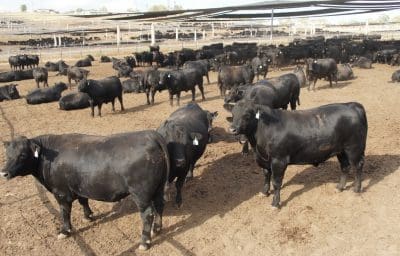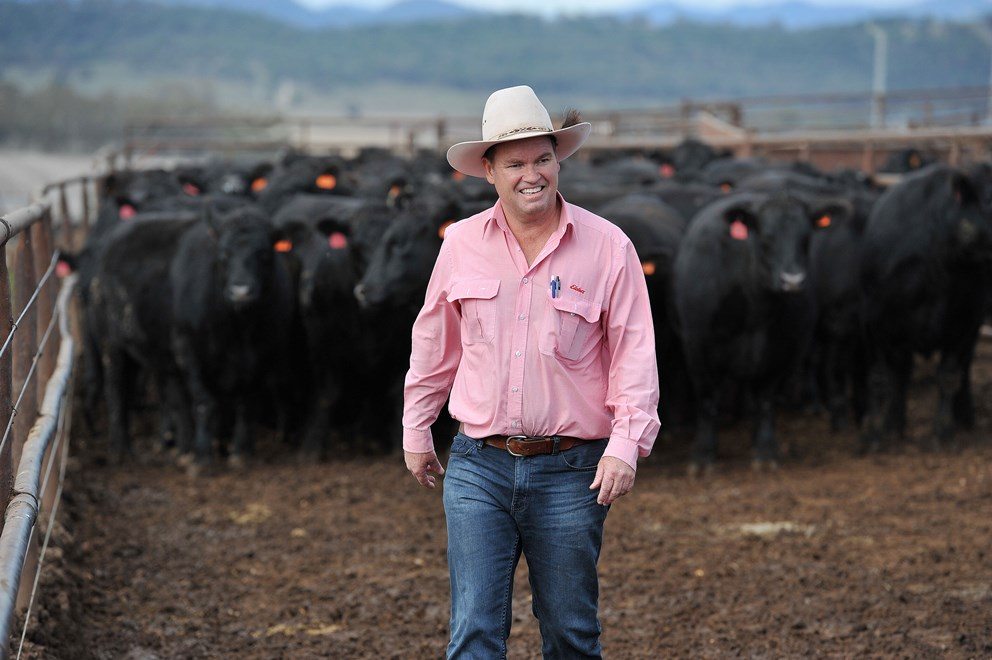COMPENSATORY gain has been a considerable factor in unusually good feeding performance in cattle in many Australian feedlots during 2018.
With the onset of drought early in the year, young cattle across many regions in the eastern states have suffered nutritional setbacks in the paddock, arriving at feedlots at lower weights and in lighter body condition relative to age than would normally be the case.

150-day grainfed Angus steers about to close-out at NH Foods Whyalla feedlot near Texas.
According to a definition from the FutureBeef knowledge centre website, compensatory gain in cattle is the process where if growth is less than normal for some months due to under-nutrition (ie drought), then later when good nutrition is available (ie lotfeeding phase) the liveweight gain of the cattle will be greater than would otherwise be expected. It means that there is a ‘rebound’ effect.
Feedlot nutritionist Dr Rob Lawrence from Integrated Animal Production said many commercial feedyards had noted compensatory gain occurring in feeder cattle this year.
He said in some cases with feeders in low body condition relative to frame, caused by drought, compensatory gain could add an additional 9-12 percent to expected average daily weightgain performance.
The trend was probably more evident in cattle fed for 100-day programs or longer, rather than yearlings.
While compensatory gain itself represented a potential bonus for lotfeeders buying feeder cattle (arguably at the expense of the cattle producer who has ‘lost’ that residual gain performance), the flipside was that those nutritionally-compromised feeders could take longer to adapt to feedlot rations after entry, Dr Lawrence said.
In some cases they could take 20-30 days to adapt to nutritionally-dense feedlot rations – perhaps double the time of other cattle.
“So the two factors can work against each other, to some extent,” Dr Lawrence said.
Even though lotfeeders had wanted to avoid it because of record high feedgrain prices, some had had to feed cattle longer than normal for 70-100 day programs this year, because of sub-optimal starting weights and body condition this year.
Many lotfeeders this year would have factored in some compensatory gain in their feeder purchase decisions and performance projections, Dr Lawrence told Beef Central.
He said feedlot growth rate performance generally had been very good across the industry this year (see comments from Elders Killara feedlot below).
That was partly due to dry, stable and relatively mild weather conditions conducive to better feeding, as well as more cattle suppliers using grain and self-feeders in the paddock before sale, setting young cattle up better for transition into the feedlot.

Killara feedlot general manager Andrew Talbot
Killara’s experience
Elders Killara feedlot near Quirindi, has been in the epicentre of the drought’s impact in NSW this year, and has seen the impact of compensatory gain in feeder cattle purchased during 2018.
General manager Andrew Talbot said like many lotfeeders this year, Killara had been forced to feed cattle that were probably 50kg below optimal entry weights.
“Because of the seasonal pressures, feeders were possibly only 2-3 months younger in age, but 50-60kg lighter than what they would normally be when sold to us,” he said.
In trade heifers, for example, instead of the normal 350kg liveweight animal, this year’s intake was often more like 300kg, or less. Angus feeder steer weights were more typically 370kg, instead of around 430kg.
But they were often also slightly younger in age, because producers had been forced to turn young cattle off early because of lack of feed and water. The net result was feeder cattle that were often 30kg underweight, based on condition score and equivalent age.
“That did two things. On the plus-side, it gave us compensatory gain possibilities, but on the negative side, it opened the door for health challenges, because the younger and lighter feeder cattle get, the more prone they are to respiratory problems,” Mr Talbot said.
“There’s no doubt that the feeder cattle that came in after nutritional stress this year had the potential for very strong growth performance. But that same stress also risked compromising their immune systems.”
Young cattle that had been on low quality pastures, some going backwards in weight, often did not have the body condition to fall back on, in the first couple of weeks after transition into the feedlot.
Killara managed the health challenge danger by ensuring most of the cattle fed this year carried some protection through BRD vaccination using Bovillis MH.
“As a result, they were able to deliver that compensatory gain that was on offer,” he said.
Phenomenal feedlot performance
Right across the Killara feedlot, Mr Talbot described cattle performance over the past six to eight months as having been “quite phenomenal.”
“I’d suggest it has been 15 to 20 percent up on the average for the last five years. That has not been all based around compensatory gain-based, though. The last six months have been ideal cattle feeding conditions – very mild, feedlot pens have been clean and dry, so there has been a range of contributing factors.”
Typical Angus steers in Killara’s HGP-free mid-fed 150-day program that might have averaged 1.55kg/day gain over the longer-term, had averaged 1.75kg/day over the last 6-8 month period. The general manager of NH Foods Whyalla feedlot near Texas on the NSW/QLD border, Tony Fitzgerald, made similar remarks to Beef Central about this year’s exceptional feeding performance during a recent interview.
“There’s no doubt that the high level of feeding performance that feedlots have experienced over the past six months has assisted greatly in a year when feedgrain prices have hit record highs,” Killara’s Andrew Talbot said.
“It has allowed exporters to remain a little more competitive in the global beef market than what we otherwise might have thought.”
Because feeder cattle entering Killara over the past six months have tended to be a little younger than normal due to seasonal pressures, there had been a slight reduction in marbling performance recorded – simply because the carcases had less maturity at slaughter (maturity is linked to expression of marbling potential, being harder to achieve as cattle get younger.)
“That reduction in marbling was not linked to genetics, it was just lack of maturity at slaughter due to the supply pressures pushing cattle into the feedlot, and perhaps the fact that they had a harder time in earlier life back on the farm,” Mr Talbot said.
Whereas Killara’s typical feeder steers bought for its mid-fed program averaged 430-440kg at 18 months, this year’s drought pressure had seen many mobs averaging 380-400kg, at 12-15 months.
Paddock feeding trend
Another strong trend evident in feeder cattle performance at Killara during this year’s drought had been exceptional feed conversion figures.
“I put that down to two things,” Mr Talbot said. “Younger cattle tend to convert better anyway, but perhaps more importantly, because of the conditions, a lot more feeders we purchased this year had already learned to bunk-feed while still on-farm, often with grain or a higher-energy supplementary ration.
“As a result, the ability of those cattle to convert feed into body weight over the past six months has been pretty impressive. Generally, our mid-fed 150/160 day steers convert at around 9.0kg of feed per 1kg of bodyweight gain (as fed basis), but over the last 6-8 months they been converting at mid to high sevens, to low eights,” he said.
“There’s been significant improvements in feed conversion as a result of feeding younger cattle, number one, and being trained in the paddock to feed from a trough, on a grain-based ration, number two.”
Interesting lessons learned
Mr Talbot said he thought some interesting lessons had been learned by the feedlot sector as a result of the 2018 drought.
“The first is that value of some bunk-feeding of young cattle in the paddock before they get to the feedlot, in terms of setting cattle up for later growth rate and conversion performance. I think we will now see more of it, even if seasonal conditions return to more normal patterns.”
“The second point is that I think feedlots may now have developed an appetite to buy lighter liveweight cattle (especially steers for longer feeding programs), having understood how well this year’s younger cattle did on feed.”
Typically feedlots feeding midfed programs around 150 days in the past have sought feeders 400-520kg liveweight, to average 450-470kg. But especially while high grain prices were around, some of these might now drift below 400kg to chase the benefits of better feed conversion efficiency and weightgain.
“It’s shown that proper preparation back on farm with some bunk feeding really allows those cattle to perform when they arrive at the feedlot,” he said.
That trend was less likely in younger cattle entering 70-100 day programs, because of the younger entry weight age profile.
“There’s no doubt that when lotfeeders start to introduce feeders at or below 300kg, they can enter into a world of pain. The health challenge escalates, and the cattle are generally too immunologically naive and immature to feed.”
For this reason, after the drought cycle is over, Killara will be aiming to get its yearling heifer entry weights back up into the ‘300s’ fairly quickly, Mr Talbot said.
“For respiratory health reasons, we’d like to return to 320-330kg minimum entry weights for our trade heifers as soon as we can, after producers have had some rain relief,” he said.
